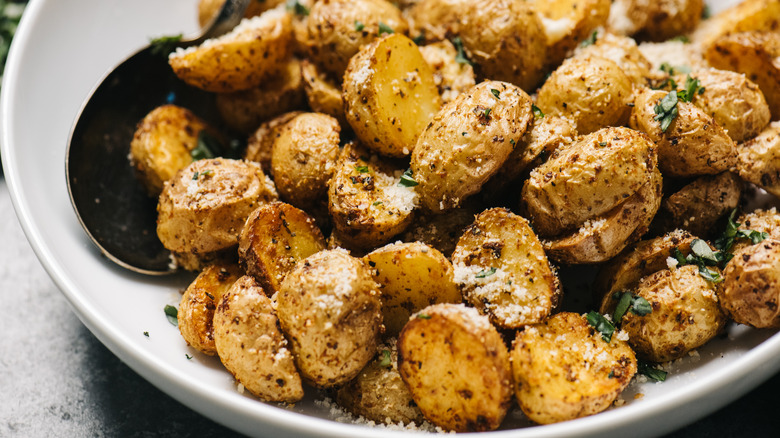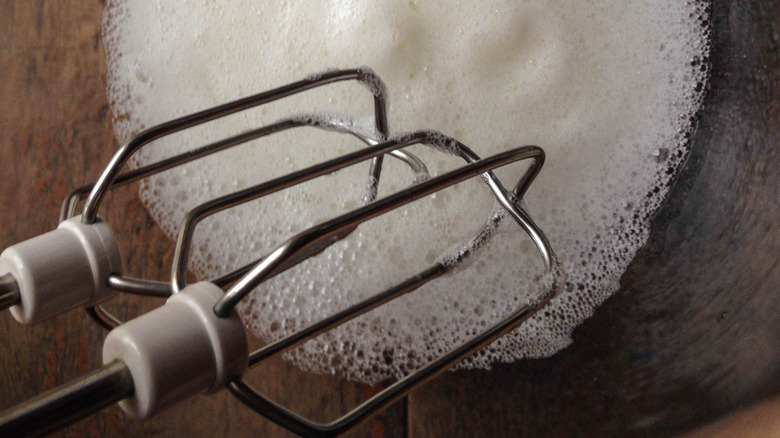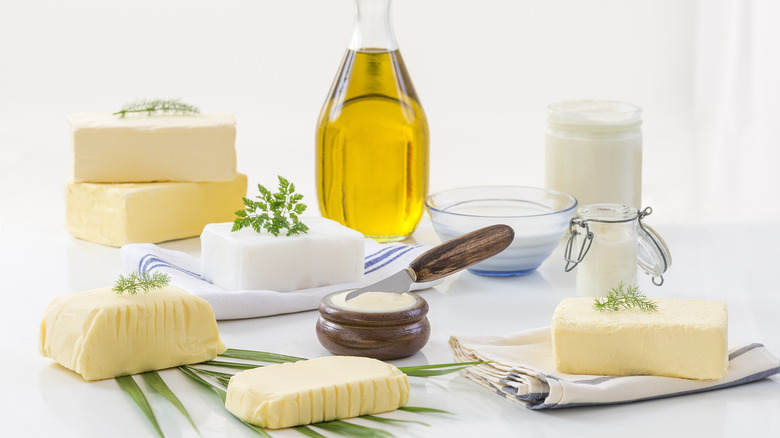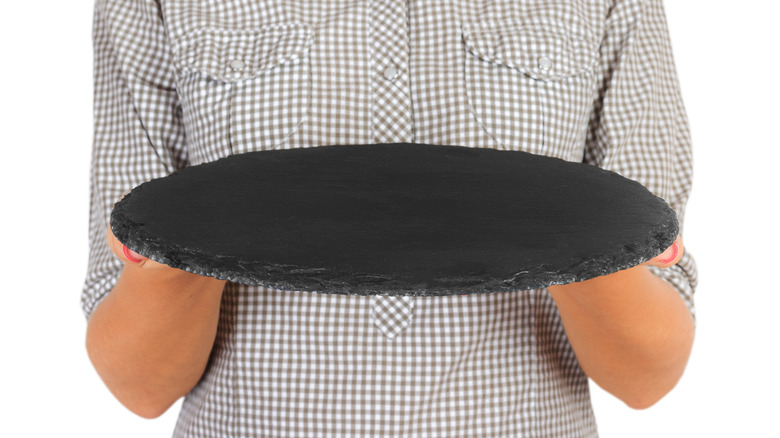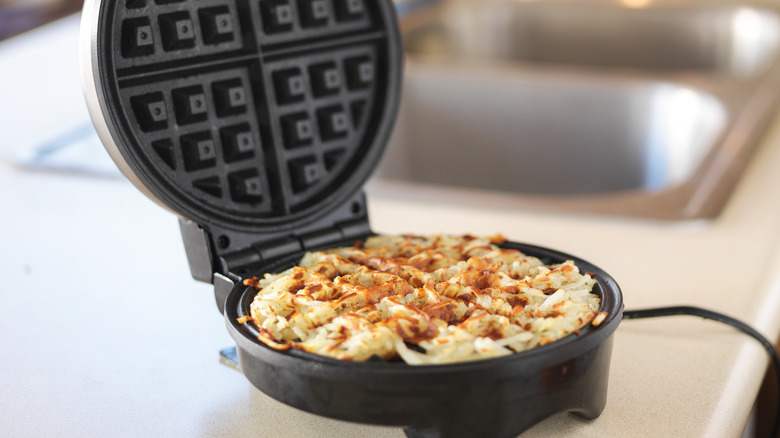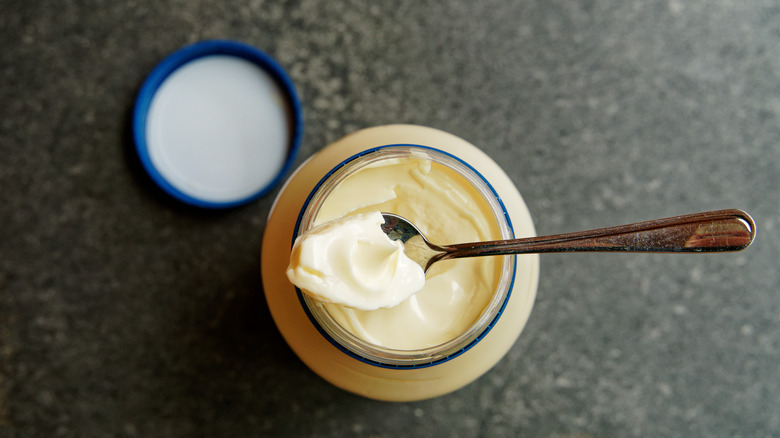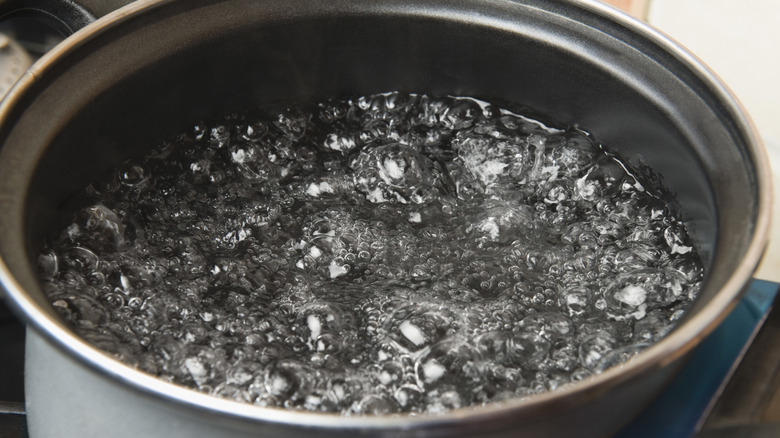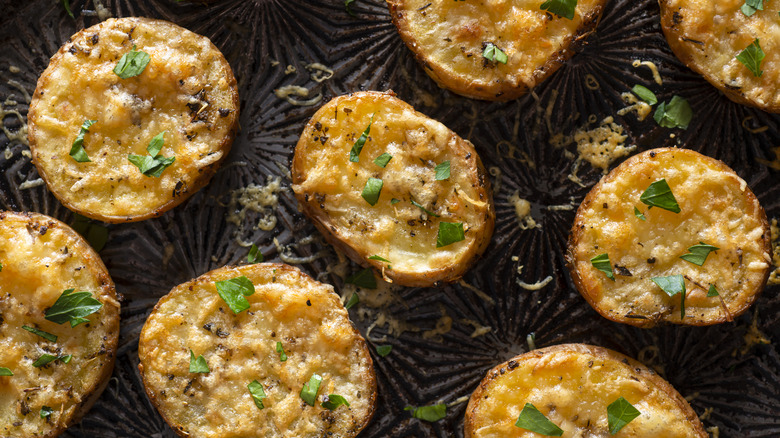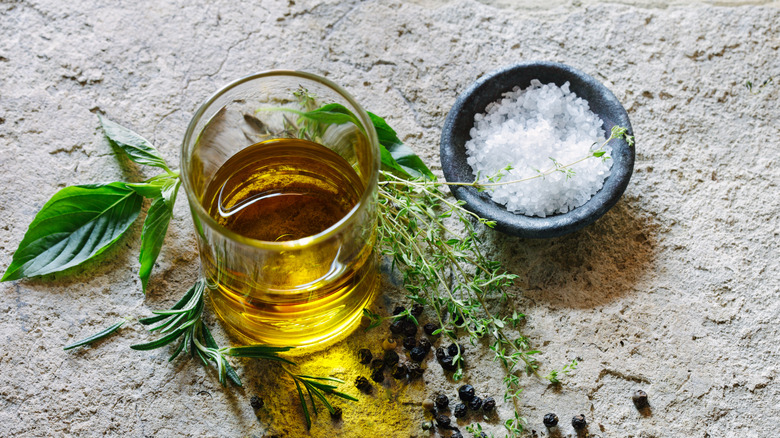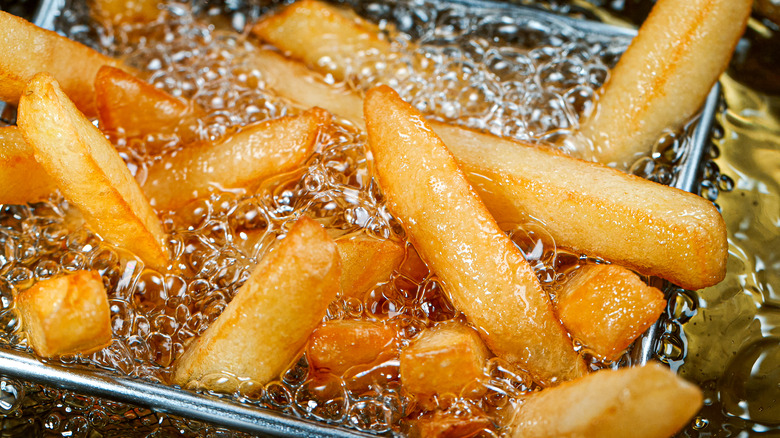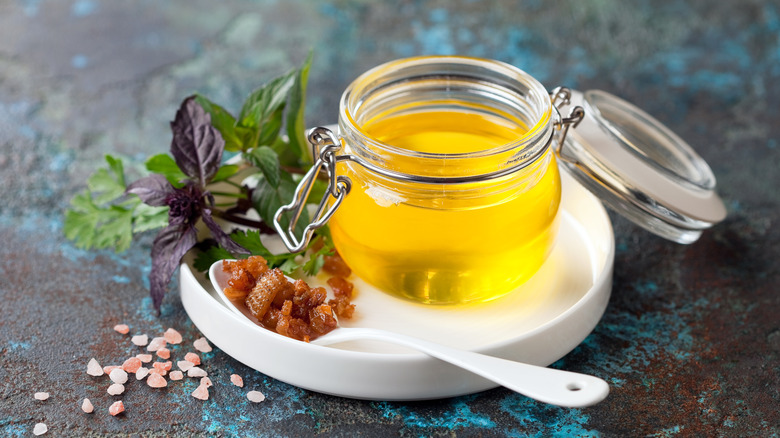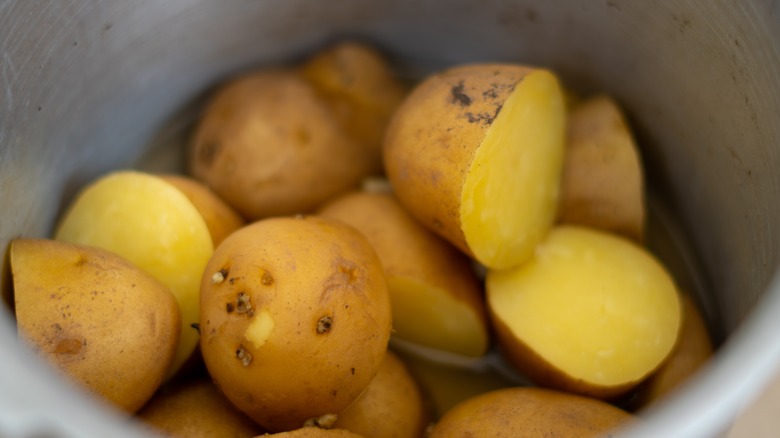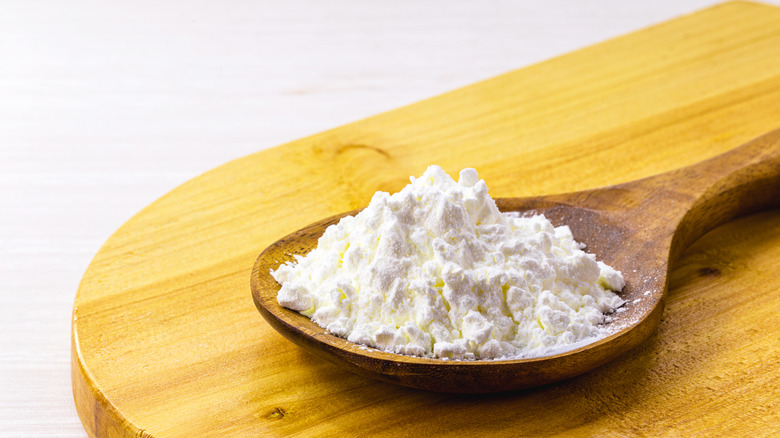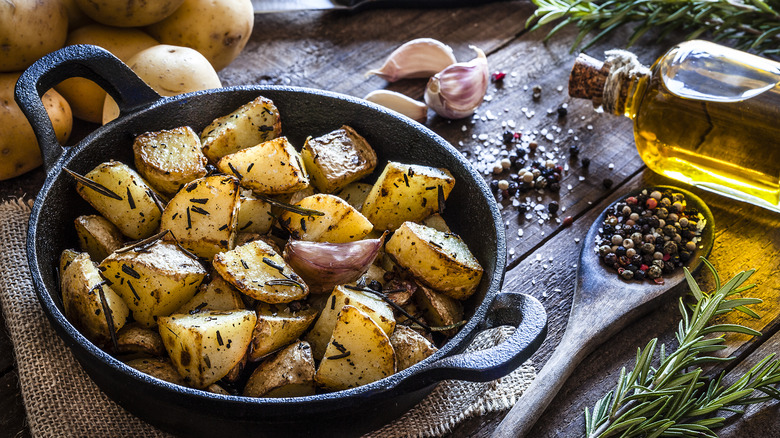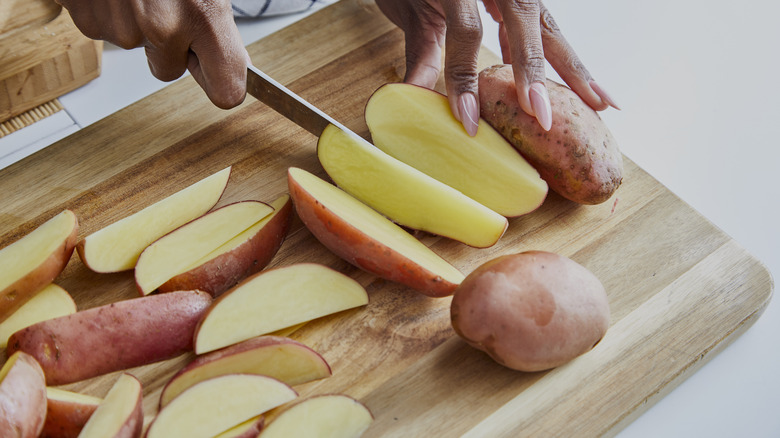14 Unexpected Ways To Get Crispier Potatoes
Cooking the interior of potatoes is a piece of cake since you just need them to be fork-tender, and you're good to go. However, getting the potato skins to have the perfect mouthfeel can sometimes be challenging. If you wait too long for them to brown, the rest of the potato is overcooked. Don't fret, though. It's certainly possible for your potatoes to have a pleasant crunch without being dry or overly mealy beneath the surface. One of the factors to consider is what type of potato you're using.
Russet or Yukon Gold potatoes are the optimal types because of their starchiness levels and skin texture. Fingerling potatoes have a thin skin but don't fall apart when you expose them to high heat, so they are an option, too. The techniques you use to prep and cook the potatoes are equally crucial. Luckily, there isn't just one way to succeed. These clever tricks will help you create flavorful, golden-brown potatoes with the perfect crisp-to-tender ratio, and they're simple enough for anyone to follow.
1. Toss them in egg whites
Did you know you need egg whites for the crispiest roasted potatoes ever? Before you shut the idea down, just know that the potatoes don't turn out eggy. This technique is common among chefs with other types of foods, too, like candied nuts. When you coat food in raw egg whites and bake it, the eggs cook, creating a skin that traps any moisture inside and helps the food's surface caramelize. To try it with potatoes, whip up some egg whites until they're light and frothy but not so much that they become meringue-like.
If possible, put on some gloves and fold the whites and the potato chunks with your hands, ensuring you do a thorough job. If the potatoes still feel dry, you can add more whites, and if there's excess liquid dripping, simply discard it when you transfer the spuds to the baking sheet. Incorporate any preferred spices after you distribute the egg because the seasonings cling much better. You can also cook these potatoes in the air fryer if there is enough space for airflow around them.
2. Bake them with multiple kinds of fat
Rather than just sticking to exclusively oil when you roast crispy potatoes, try to switch it up and use more than one kind of fat. For instance, toss your potatoes in a small amount of butter and olive oil. Butter is comprised of primarily saturated fat, with less monounsaturated and polyunsaturated fats. Meanwhile, olive oil has up to 75% monounsaturated fat. All types of fat help add crispiness to potatoes, but the unsaturated fatty acids provide a deeper flavor when the Maillard reaction occurs (the chemical reaction that causes browning and more complex flavor in foods). One thing to keep in mind is their smoke points, though.
Butter reaches its smoke point at 350 degrees Fahrenheit, and extra-virgin olive oil is more towards 375 degrees Fahrenheit. You can always experiment with clarified butter instead, which lasts 100 degrees more than regular butter before it smokes. No matter what, when you roast potatoes this way, it's a good idea to boil them beforehand. Furthermore, don't disturb the potatoes too much when they cook because that causes sticking. If you leave them alone, a nice crust forms underneath because of the direct heat from the pan.
3. Roast them on a pizza stone
Manufacturers usually make pizza stones with ceramic, stone, or other composite materials, and it's not a coincidence why. Nobody likes a soggy pizza crust, but when you cook it on a porous surface, it aids the pizza dough in becoming the perfect texture. You can also make roasted potatoes on a pizza stone if you want them extra crispy instead of something more familiar, like a sheet tray. This simple swap ensures that any unwanted water in the potatoes is soaked up, allowing a coating to form during cooking.
If you've never used a pizza stone, it's important to note that it can crack from heat shock if you don't use it correctly. You must place the pizza stones in the oven while it heats to increase their temperature slowly. This helps your potatoes, too, since you can place them on an already-hot surface to kickstart the browning process. It is also a good idea to parboil the potatoes when using this trick. Lastly, spread the potatoes out on the stone because they take longer to turn crispy if they don't have enough room.
4. Shred, then cook them in a waffle iron
This hack doesn't necessarily work if you are set on having potato wedges, cubes, or another specific shape. However, if you are open to new things, this method produces some pretty crispy potatoes, which you can use in various ways. You only need a cheese grater or food processor to shred the potatoes. Then, place them in a waffle iron and cook them until crispy.
This genius idea was posted by a Redditor in the food hacks community. It works so well because the waffle iron produces direct heat on both sides of the potatoes simultaneously. When you spread out the thin shreds, they have a larger surface area, which helps with browning. If you try this yourself, soak potatoes in cold water and squeeze the excess water out before transferring them to the waffle iron. Otherwise, they don't crisp as much. And, since the potato pieces are so small, you don't necessarily need to worry about cooking the potatoes beforehand. You can put them in the waffle iron raw.
5. Coat the potatoes in mayo
Mayo is the surprising ingredient for crispy roasted potatoes because it gives them a deep golden color and ideal texture. You might only think mayo adds moisture to food, like when you slather some on a burger bun to make the sandwich saucy instead of dry. However, you can use it in the opposite way: to help food become crispy. Some folks use this hack to make fantastic grilled cheese by spreading it outside the sandwich slices. Then, the bread forms a crunchy coating when they cook it on the pan or panini press. The same applies when you coat your potatoes in mayo, either partially through the cooking process or before you bake them.
This method is beneficial since you can use it with any potato cut you wish. And no, your spuds don't end up tasting like mayonnaise, so don't worry. Mayo, in its simplest form, is a combination of eggs, vinegar, and oil. Some products, like Kraft mayonnaise, have other ingredients, like seasonings and sugar. For the Maillard reaction to occur, you need to heat sugar and amino acid proteins. Eggs also create browning, hence why the combination of ingredients in mayonnaise boosts the chemical reaction.
6. Boil them with baking soda
Next time you cook potatoes on the stovetop, boil the potatoes with baking soda to give them crispy skin. Especially if you're someone who always boils your potatoes before roasting them anyway, it doesn't cost you any extra time. All you need to do is go to your pantry and grab a dash of baking soda, which changes the pH of the water. You might wonder how pH levels affect the crispiness of potatoes, and well, it's because when you alkalize the water, the starch from the potatoes is released, and the pectin degrades.
More specifically, the starches form a layer on the exterior part so that when you bake them, the surface of the vegetables turns dry. This means they're tender inside while still having a nice bite — no mushiness. The neat thing about this trick is that you can use it for all sorts of dishes, whether you plan to make homemade fries to go with your lunch or breakfast potatoes to accompany your omelet.
7. Use parmesan cheese
If you've ever cooked with grated parmesan, you might notice how it can turn into a crust when you cook it long enough due to its low moisture content (it only contains 32% or less moisture). Therefore, this hack from a TikTok video works so well because you can use parmesan to its advantage for crispiness and flavor. But, instead of coating the potatoes directly in parmesan, you make a paste to spread on the bottom of your pan. Mix melted butter, grated parmesan, and an assortment of seasonings until smooth, then spread it evenly in a baking dish.
Cut baby potatoes in half, score them on the flat side, then press them against the paste. Only place a single layer of them into the pan to avoid overcrowding, then add some melted butter and parmesan on top, too. Roast them until the underside has a deep color and easily releases, indicating that the cheese has transformed into the crust. Of course, make sure the potatoes are fork-tender, too. As long as you use potatoes on the smaller side, you don't need to parboil them.
8. Marinate them with salt and oil for several hours
Salt draws out moisture from food, which is why people use it to dry food like meat for preservation (through a process called osmosis). You can use this tidbit of information when you plan to make potatoes. If you coat chopped potatoes with salt and fat (such as olive oil) and allow them to marinate for a while, you end up with a crunchier final product. Especially if the potatoes have a lot of water in them, the salt helps to omit the excess. Then, of course, the fat helps the food to stay hot, contributing to the browning of the potatoes.
A Reddit user stated that this is their go-to trick for potatoes and that they place the salted potatoes in something like a Ziploc bag and wait a few hours while it is in the refrigerator. Then, they roast them in a 400-degree Fahrenheit oven. While this method works for roasting, avoid doing this with other types of cooking. For instance, if you add salt to potatoes before you fry them, it contributes to the degradation of the frying oil, meaning that you don't get as much use out of the oil because its quality deteriorates.
9. Boil tpotatoes in vinegar water, then double-fry them
When it comes to delicious potatoes, Ethan Chlebowski has a precise technique that he uses. You've heard about adding baking soda to your water, but did you know you can use vinegar instead for a similar reason? In a YouTube video, Chlebowski explains that adding a small amount of vinegar changes the water's pH and prevents the natural pectin in the potatoes from dissolving, keeping the potato's structure strong.
He continues his process by frying the potatoes not once but twice. The first round helps the starch concentrate, and the second round turns the gelled starch into a crust twice as thick as usual. The potatoes don't fall apart when you cook them like that since you introduce them to the vinegar beforehand. Therefore, Chlebowski believes combining all these steps leads to potatoes with a nice outer coating. While his recipe is for straight-cut french fries, you can also use it with other potato cuts too.
10. Use goose or duck fat
Many countries, such as Poland, Hungary, and France, use goose fat in their cooking because it gives food a pleasant, crunchy texture. Goose fat has a composition of monounsaturated and saturated fat and can withstand high temperatures before it smokes. The only downside is that goose fat isn't as widely available in the U.S. as in other countries. Luckily, you can use duck fat, which has a similar makeup, since both animals are a type of waterfowl. They have slight differences, though, such as flavor and smell.
Goose fat is generally milder, while duck fat has some aroma and more flavor. You can't lose with either option, though. Celebrity chef Jamie Oliver prefers goose fat, which he mentioned in a YouTube video. Meanwhile, Gordon Ramsay claims on his website that duck fat is the best option for browning potatoes, so it's up to preference. To use one of these fats, coat the potatoes before you bake them so it functions as a seal, preventing moisture from escaping and turning the potatoes mushy.
11. Pressure cook, then sauté them
Many pressure cooker recipes say to sauté potatoes to brown the outside before you cook them internally. However, although this gives the veggies color, the final product is soft. If you plan to cook the potatoes on their own instead of as part of a soup or dish, try cooking them in the opposite order. Some of these machines have different settings, so you can remove excess liquid and sauté them right in the appliance, saving you from cleaning extra dishes.
For example, use an Instant Pot or similar machine to cook the potatoes until they're nearly fork-tender. Then, stir in some type of fat and your favorite seasoning. Sauté the potatoes with high heat so they turn out both fully cooked and crispy. Furthermore, this trick works best when you use small potatoes because it's easier for them to cook all the way through, and you don't need to worry about chopping.
12. Coat the potatoes with cornstarch and spices
Although potatoes are naturally starchy, adding extra starch helps enclose the moisture inside while turning the skin crunchy. Specifically, you can make a coating mixture of cornstarch and spices next time you cook potatoes. There are some preparation steps to follow for this approach to work successfully. First, soak the potatoes in a cold-water bath (overnight is best if you have the time). Then, rinse, dry, and toss the potatoes in oil before introducing the cornstarch mixture, which helps it adhere much better.
Some folks might use flour as a coating when making things like fried chicken or french fries, but cornstarch contains a higher amount of amylose than wheat flour, so it's the better option. The cornstarch method works whether you plan to make roasted or air-fried potatoes of any shape. It's also an excellent method to prevent traditional french fries from turning soggy.
13. Use a cast iron skillet
A cast iron skillet can be your best friend when you want potato bits with golden shells and soft interiors. This type of cookware is known for its ability to retain heat. Plus, cast iron pans are seasoned, meaning your potatoes don't stick while browning, as long as you slowly bring the pan up to temperature before you use it. This is favorable because it can get frustrating when your potatoes form a crust but stick to the cooking surface, leaving you with the soft part of the food.
You can use this type of cookware on the stovetop or in the oven. In the oven, cast iron works much better than a sheet tray since it holds the heat more evenly, which is why you see bakers making skillet cookies or even fruit cobblers with it — the pan prevents the food from burning. As for the stovetop, it gives the potatoes direct heat but in a gentler way since the pan is thicker than the average frying pan.
14. Cut them at a 30-degree angle
Surprisingly, the way you cut your potatoes might enhance their ability to deepen in color and have the ideal texture you're looking for, according to a Daily Mail study. The study examined the difference between when people cut potatoes at a 30-degree angle versus the more common 90-degree cut. They found that when you slice them diagonally, the potatoes achieve the highest level of crunchiness, compared to if you simply cut cubes (because of the larger surface area).
Moreover, the wedge potatoes developed a more complex flavor when roasted. So, next time you make a dish that allows you to cut the potatoes however you want, opt for the slanted cuts. Just make sure to use a sharpened chef's knife because cutting them with a dull knife can be a hassle. You want the knife to go through the potato without too much difficulty.
